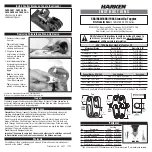
AC136
Panic Button
The AC136 Panic Button is a Z-Wave Plus
TM
enabled device and is fully compatible with any Z-Wave
TM
enabled network. The device can be set up in a Z-wave network to communicate directly with other end
devices such as lighting controllers, or to report directly a Z-wave controller (usually a gateway).
The Panic Button is a portable wireless switch designed to control the Panic/Disarm status of other
associated devices thru the Z-Wave
TM
controller. After receiving the signals emitted by the Panic Button,
the Z-Wave
TM
controller can then give commands or operate according to its own settings. Its great
compatibility with Z-Wave
TM
products makes it suitable for smart home cloud based platforms.
Product Overview
3
3
LINK
4
5
5
6
7
Front View
Panic ON/OFF Knob
Panic ON/OFF Knob
Inside View
Battery Compartments
Link Button
Rear Cover Latch
LED Indicator
Rear View
Rear Cover
Adding to Z-Wave
TM
Network
Auto Inclusion
The detector supports Auto Inclusion feature where it will automatically enter Inclusion mode when first
powered up after a factory reset.
1. Gently lever the bottom edge of the front cover to detach it from the main body.
2. Put a Z-Wave Controller into inclusion mode.
3. Insert 2 AAA-size 1.5V alkaline batteries to battery
compartment with the correct polarity. The LED on
the device should turns ON.
4. The Inclusion process should be completed when the LED turns off.
Note: If Auto Inclusion fails, refer to the Troubleshooting section regarding Manual Inclusion.
Testing
1.
For the Panic Button to control other devices on the Z-Wave
TM
controller by 2 seconds long pressing
for Panic and 10 seconds long pressing for disarm, a Scenes needs to be created. Scenes are user
defined elements in controller that determines what actions to take when an event occurs. The
Panic Button creates the event to this Scene which then controls other activation devices such as
plugs or dimmers, or perhaps set the alarm to Arm or Disarm mode.
2.
After binding with the Z-Wave
TM
controller, the Panic Button will send data about its battery power to
the Gateway after about 2 minutes. Subsequently it will send the data once the button is pressed..
Installation
The Panic Button can be installed on the wall either by using the supplied double-sided tapes or the
screws:
1.
Using the double-sided tape: first peel one side of the tape and place the sticky side onto the back
of the Panic Button. Then peel the other side of the tape and attach the unit onto a proper location
on the wall.
2.
Using the screws:
i.
Detach the rear cover by removing the front cover and then pressing the rear cover latch
(see item in Product Overview).
ii.
Use the rear cover as a template to mark on the wall the positions of two screws. The marks
should be in horizontal positions and the distance between the two marks is 60mm.
iii.
Drill the holes using an appropriate size drill bit. Insert the supplied plastic wall plugs first for
a cement wall. For a wooden wall the wall plugs would not be needed.
iv.
Position the rear cover on the wall and turn the two screws into the wall (or wall plugs). DO
NOT fasten too tightly as the rear cover might be damaged. Then replace the main body
and the front cover.
Note:
Ensure the unit is installed within transmission range of the gateway using the test above.





















